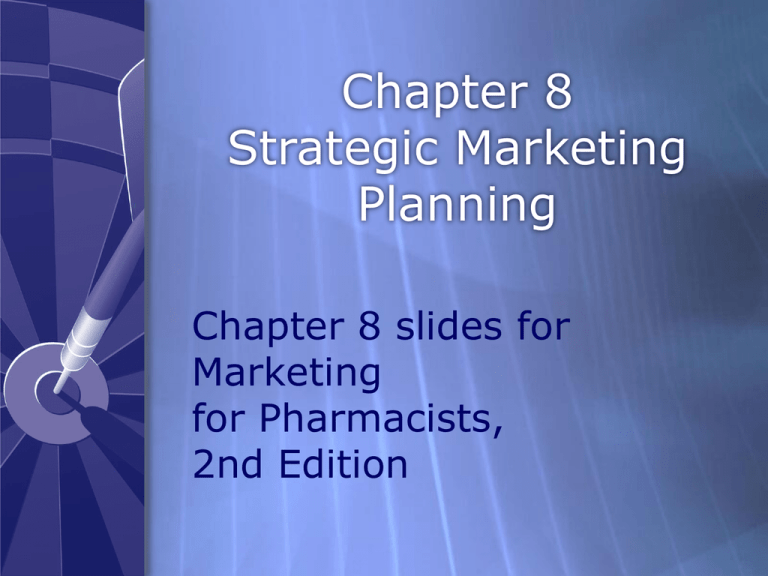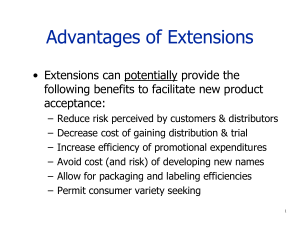Chapter 8 - Strategic Marketing Planning
advertisement

Chapter 8 Strategic Marketing Planning Chapter 8 slides for Marketing for Pharmacists, 2nd Edition Learning Objectives Describe the strategic planning process. Discuss the role of strategic marketing planning for pharmacists. Define the following terms associated with strategic planning: mission statement, business plan, SWOT analysis, marketing goals and objectives, brand, commodity, brand awareness, brand image, brand equity. Develop a strategic marketing plan for a pharmaceutical service or product. Role of a Mission Statement TIP All planning and strategies originate from it. Every part of a business plan derives from the mission. Mission Business Plan Marketing Plan Financial Plan Human Resources Plan Distribution & Supply Vision without action is a daydream. Action without vision is a nightmare. - Japanese Proverb Strategic Marketing Plans A step-by-step plan for solving marketing problems Strategic marketing plans Can be conducted any time you have a marketing problem New service (diabetes management) Change in services (Internet pharmacy) New competitor (Wal-Mart) In pharmacy, many services are provided on hit or miss basis without much planning. Wal-Mart fills $4 generic prescriptions Wal-Mart Stores announced the expansion of a generic prescription drug discount program introduced last month in Florida to additional states. Wal-Mart said that the program has received a strong customer response in Florida. In the Tampa area, Rxs increased by 36,000 in the first 10 days of the program. The generic medications in the program account for almost 30% of the Rxs filled at Wal-Mart pharmacies in Florida. http://www.npr.org/templates/story/story.php?storyId=6326035 Analyze Resources Step 4 Reassess Developing the Strategic Marketing Plan (Strengths, Weaknesses) Mission Statement Step 1 Formulate Goal Analyze Environment (Opportunities, Threats) Strategic Marketing Planning Process Step 3 Implement Step 2 Develop Strategy 1. Segment the market 2. Select a target market 3. Position your product SWOT Analyses Strengths, Weaknesses, Opportunities, Threats SWOT analyses Each SWOT is unique. Require a clear understanding of the competition. Elements of SWOT are framed in comparison with competitors. A location is a strength as it compares with competitors. A threat occurs within the context of competitors. Capability assessment Strengths (S) Weaknesses (W) Strengths or weaknesses of your organization People/skills - Availability and training of personnel that give you an advantage Money - Availability of $ to finance initiatives Systems - How well designed, organized, and coordinated is your system? Facilities - Availability and condition Market assets - Image/reputation in the eye of the customer. Degree of market leadership. Analyze the market environment Opportunities (O) Threats (T) Opportunities What needs are not being met in the marketplace? Can we meet these needs better than our competitors? How is the environment changing to our advantage or disadvantage? Threats What potential problems might threaten the success of the firm initiatives? What potential new competitors may arise? How might the firm’s current competitors respond? What changes may be occurring in the environment to make your product or service obsolete? Threats How might governmental policies, changing customer demographics, or a recession affect your firm’s product or service? How might changes in customers’ tastes affect customer demand? What major trends will significantly affect your firm and the market? Retail clinics – Threat or opportunity? Medicare Prescription Drug Benefit (Part D): Threat or opportunity? Identifying opportunities and threats in markets (Porter) Level of rivalry between competitors Ease with which competitors can enter market Power of suppliers (e.g., pharmacies) Power of customers (e.g., PBMs) Availability of substitutes Summary -SWOT is used to answer: Does the company have a distinct advantage in the current market environment upon which a strategy can be built? Do weaknesses make the company vulnerable to competitors or disqualify it from pursuing certain opportunities? Strategy Formulation The plan to achieve marketing goals and objectives Analyze Resources Step 4 Reassess (Strengths, Weaknesses) Mission Statement Step 1 Formulate Goal Analyze Environment (Opportunities, Threats) Strategic Marketing Planning Process Step 3 Implement Formulating goals, objectives, and strategies Goals: General outcome of anticipated actions, e.g., “increase company profitability.” Objectives: Quantify general outcome, e.g., “increase ROA by 10% by end of fiscal year.” Strategy: Plan to achieve goals and objectives. How will you segment your market? (Ch.10) What segments will you target? (Ch.10) How will you position your product in the market? Positioning Pharmaceutical Services Goal -Develop a clear, distinct, and valued image of your mix in the minds of consumers. Positioning, SWOT, and the Marketing Mix Using information from SWOT analysis, Select a unique combination of 4 P’s That meets your customers’ needs and wants better than your competitors do. All 4 P’s should act to provide a consistent and powerful image of your product or service. Don’t become a commodity Commodities are products in which consumers can’t perceive any difference, e.g., gasoline. They are selected on the basis of price and location. Brands and Branding A brand is a name, term, sign, symbol, or design that helps identify a product or company. Branding attempts to get consumers to assign meaning to a brand. TIP Your personal brand is your name. Keller, Kevin Lane. “Conceptualizing, Measuring, and Managing Customer-Based Brand Equity.” Journal of Marketing. 57(January 1993). 1-22. (Adapted) Brand Recall Brand Awareness Brand Recognition Keller, Kevin Lane. “Conceptualizing, Measuring, and Managing Customer-Based Brand Equity.” Journal of Marketing. 57(January 1993). 1-22. (Adapted) Types of Brand Associations Favorability of Brand Associations Strength of Brand Associations Uniqueness of Brand Associations Brand Image Customer Experiences with the Marketing Mix •Price •Promotion •Place •Product Customer Experiences from Others •Word-of-mouth recommendations •Press and other media coverage Brand Awareness •Recognition •Recall Brand Image •Types of associations •Favorability •Strength •Uniqueness Brand Equity Problems faced by pharmacists in changing their brand’s image The image of pharmacists is controlled by others. Pharmacists are unwilling to exert the effort. Pharmacists don’t know how. Implementing the Plan Problems in implementation: Insufficient management commitment Lack of staff commitment or expertise Lack of or poor information Structural contradictions Overextension Final Step: Reassess Evaluate marketing success and ways to improve. Conclusion Students and pharmacists should know how to develop a strategic marketing plan. Clerkship Practice Career planning Questions?











